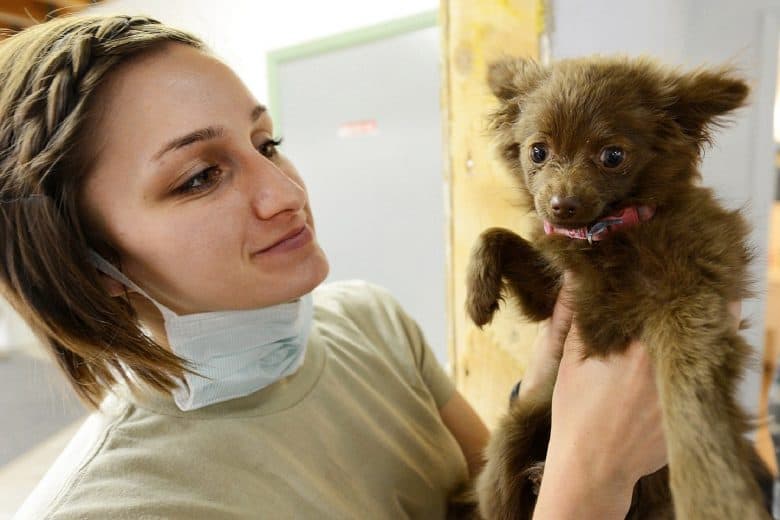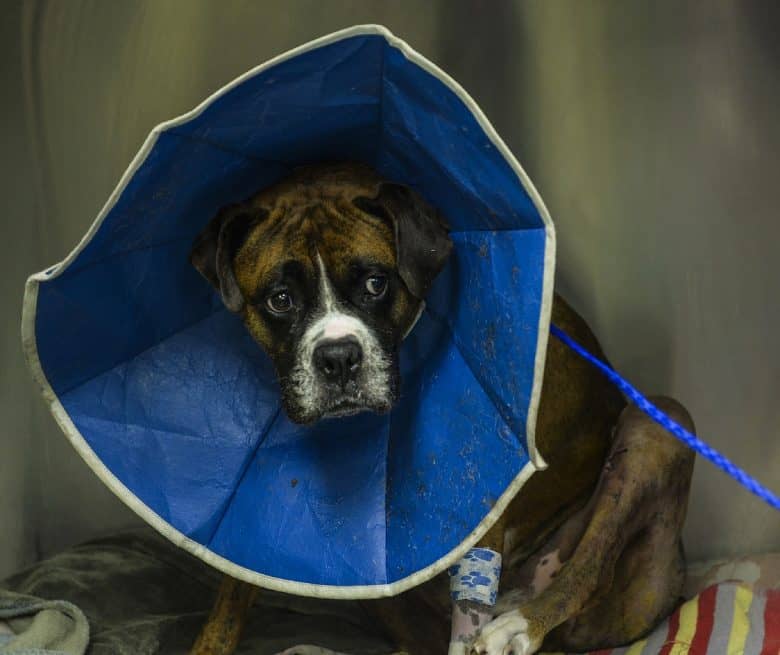Last Updated on February 26, 2023
We tend to focus on the cuddles, bonding, and “ahhh so cute” moments of dog ownership. But, part of our responsibility as pet owners means taking care of the health of our beloved fur babies as well.
Today, we are going to discuss a highly common health issue. Let’s take a look at dog vaginitis from all angles, covering the causes, symptoms, treatment, and more!
Quick Navigation
- 1 What does Vaginitis in dogs mean?
- 2 Two types of vaginitis in dogs
- 3 Symptoms: Clinical Signs of Canine Vaginitis
- 4 Causes: The reasons behind your dog getting vaginitis
- 5 How is Canine Vaginitis diagnosed?
- 6 Options for treating vaginal inflammation in dogs
- 7 Your dog’s road to recovery from vaginitis
- 8 Further reading: Other Dog Conditions and Diseases
- 9 Reference
- 10 Medically Reviewed By:
What does Vaginitis in dogs mean?
Dog vaginitis is a non-life threatening condition that affects the female dog vagina. The causes can be environmental or anatomical, resulting in painful inflammation.
The female reproductive organs need special care, as the pH balance can easily become disrupted if harmful bacteria invade.
It can affect all female dogs despite their age.
Two types of vaginitis in dogs
No two dogs are the same, and neither are cases of vaginitis.
Age is an important factor when dealing with this health condition. It will help you narrow down what’s causing vaginal inflammation in your dog.
Knowing the different signs between a female puppy and an adult will also help you see what you can do for her so she’d feel better.
These two classifications of canine vaginitis are going to determine which diagnosis and treatment are appropriate according to your dog’s age.
Juvenile Canine Vaginitis
Simple known as puppy vaginitis, this type affects canines between 6 months and 18 months of age. You should not consider your puppy sexually mature until she experiences her first estrus or “heat” cycle.

The usual cause of vaginitis in puppies are:
- Congenital deformation of the dog’s vagina (such as an inverted vulva)
- Fecal contamination
- UTI or urinary tract infection
If a puppy exhibits symptoms such as swelling in its vaginal area, unusual discharge, or licking herself frequently, she might be suffering from vaginitis.
Don’t fret, as vaginal inflammation in puppies is not that serious. At this tender age, your dog’s body is going through several rapid changes, similar to a teenager in their puberty stage.
This can upset the pH balance of the vagina as the pup prepares to go through heat for the first time.
The best course of action is to wait and observe. Wipe the vaginal area or vulva of the puppy using unscented baby wipes. You can also use water with mild soap to relieve any itching or discomfort.
The good news is, most cases of puppy vaginitis resolve on their own after their first heat.
If the condition is severe, though, the inflammation may have developed into a bacterial infection. You’ll need to visit the vet for a more in-depth treatment, which may include medicated cleaners, ointments, or oral antibiotics.
Vaginitis in Adult Dogs
This type is also called Adult-Onset Canine Vaginitis. It’s slightly more complicated, as it can be a sign of a more serious, underlying health issue.
It can also be associated with other vaginal infections such as a urinary tract disorder or yeast infection.
If your dog has vaginitis, you’ll notice similar symptoms to that of the puppy variety. Adult dogs might display abnormal behavior, such as sudden accidents inside the house or peeing more frequently.
Unlike puppy vaginitis, you DO NOT want to wipe your adult dog’s vaginal area or vulva with wipes or wash it with soap. Doing so can further disrupt the delicate pH balance of her vagina.
Instead, take her to a veterinary clinic as soon as possible. The vet will administer tests to rule out serious diseases, such as tumors. They’ll prescribe the right treatment suited for your dog, which can range from typical antibiotics to spaying if vaginal inflammation is recurring and chronic.
Symptoms: Clinical Signs of Canine Vaginitis
Vaginitis wears many masks when it comes to deciphering the signs. It all depends on the puppy or dog in question. That’s why it’s difficult to pinpoint the exact cause of your dog’s inflammation.
There are key symptoms of vaginitis in dogs that you have to watch out for. Observe if there’s abundant discharge and an unusual color (white or yellow). It can also contain blood, but this is rare.
You’d notice that your pet’s vaginal area is swollen, and the skin is red.
Your dog might also scoot her bum across the floor to get relief and even lick her private area constantly.
Male dogs will suddenly show interest in your dog. Don’t let her engage with other dogs, as this can spread bacteria and make the inflammation worse.
Causes: The reasons behind your dog getting vaginitis
Dog vaginitis can be the result of many varying situations. It sometimes masks more serious diseases.
Some of the most common causes that you should be aware of are:
- Bacterial Infection (such as Canine Brucellosis)
- Urinary Incontinence
- Irritation from urine or fecal matter
- Canine Herpesvirus
- Foreign body migration
- Vaginal Abscess
- Ectopic Ureter
- Ovarian Remnant Syndrome (despite being spayed, the dog still goes into heat)
- Uterine Stump Pyometra (residual tissue is present after an ovariohysterectomy)
The vet in this video provides an outline of the symptoms and causes of canine vaginitis:
How is Canine Vaginitis diagnosed?
If you notice any of the signs mentioned above, don’t wait it out or try to treat your dog on your own. Vaginal inflammation is a health issue that progresses quickly. It’s imperative to take your girl to the vet pronto!
The professional diagnosis will begin with a thorough medical history, where you share all that you can about your dog’s past and present health. The vet will look at the medical record of your pet and perform a physical exam.
Expect a series of tests to be performed. These tests will include a blood chemical profile, a complete blood count, urinalysis, and an electrolyte panel. These tests are necessary to help rule out health issues with similar symptoms to canine vaginitis.
X-rays or ultrasounds may be taken if your vet suspects tumors.
A vaginal exam by finger or scope will allow the vet to check for pus, blood, feces, or deformities.
Options for treating vaginal inflammation in dogs

Once the vet has confirmed the diagnosis of vaginitis, a treatment plan customized specifically for your dog will be provided.
Luckily, surgery is rare when it comes to treating juvenile vaginitis. Just keep an eye on your pup until her first estrus or heat has passed. If the inflammation doesn’t go away after the cycle, take her to the vet for an exam.
To relieve discomfort for your pet, the vet may prescribe a topical medication.
You might be asked to put an Elizabethan collar or cone around your dog’s neck. Preventing her from licking will allow the cream to work so the skin can heal quickly.
If the cause of inflammation is a bacterial infection, your veterinarian may prescribe antibiotics. They may also prescribe an antiseptic to control the flare-up and ease the irritation.
It’s essential to stay consistent and finish the entire course of antibiotics as prescribed, even if your dog’s symptoms seem better.

For the most chronic cases of vaginitis, spaying may be recommended, because antibiotics no longer work to solve or control the problem. The procedure would consist of completely removing the uterus and ovaries.
Older female dogs may benefit from getting spayed if they get vaginitis while they are still intact.
Holistic treatment for vaginitis in dogs
There are times where vaginal inflammation is caused by factors such as weight gain, skin allergies, and food sensitivities.
If this is the case, topical treatment will only mask symptoms of vaginitis. The root of the problem should be treated and cured by changing or improving your dog’s overall lifestyle.
If you’re currently giving your dog processed foods and table scraps, stop right away.
Replace your pet’s diet with high-quality dog food or raw food that is high in protein. Choose meals that offer viable nutrition without the fillers and additives that cause weight gain.
Adding Omega 3 fatty acids, like fish oil supplements, have also been shown to help reduce skin inflammation and prevent skin allergies.
The best probiotic strains for dogs
Antibiotics are commonly used to treat vaginitis, but be aware and careful of this method. There are side effects that can disrupt the fragile gut flora of your dog.
This medication will do the job of killing harmful bacteria. In turn, they also kill the good bacteria that will impair the digestive and immune system. In some cases, this can lead to recurring vaginitis and *gulp* another round of antibiotics.
Probiotics may be recommended to help balance your dog’s gut bacteria and keep pH levels healthy if vaginitis is persistent.
If your dog has a sensitivity to dairy, there is a broad spectrum of non-dairy probiotics for dogs.
If you want to stay away from antibiotics completely, some pet owners experience success with olive leaf extract. It’s a natural alternative that is believed to have antimicrobial properties.
It’s believed that the main component of the leaf, oleuropein, does wonders to boost the immune system and fight pathogens.
Your dog’s road to recovery from vaginitis

The prognosis of vaginitis depends on how severe the case is, as well as how long the dog in question has been enduring the condition.
Fortunately, the majority of cases are a one time deal, especially if it’s puppy vaginitis. After initiating treatment, vaginal inflammation should clear up after 2 to 3 weeks.
Take a deep breath and relax! We all love our fur babies, and we’d always want the best for them. Besides taking the vital steps to get her medically treated, do what you can to establish a stress-free environment at home.
Undertake a thorough cleaning of every part of the house, especially the areas where your dog spends most of her time, such as her crate, dog bed, and couch.
Switch out foods that cause allergies, and that includes your dog’s shampoo since it can also irritate her skin.
You want to make sure your pet is comfortable while she’s recuperating because she needs a lot of rest. If you have other pets, place your girl away from them where she won’t be disturbed. It will help minimize rough play and avoid the spread of bacteria.
Finally, the very BEST treatment you can give your dog is TLC or tender, loving care. Give her plenty of cuddles and belly rubs as she heals and gets back to her old, happy self!
Has your dog had vaginitis before? Share with us your story and what you did to help her get better by typing it all in the comment box.
Further reading: Other Dog Conditions and Diseases
- Tick Borne Diseases in Dogs
- Kidney Failure in Dogs
- Dog Skin Problems
- Dog Dry Heaving
- Canine Epilepsy
Reference
- https://www.akc.org/expert-advice/dog-breeding/when-dogs-in-heat/
- https://www.petmd.com/dog/general-health/dog-vaginal-health-guide-everything-you-need-know
- https://www.petmd.com/blogs/thedailyvet/dr-coates/2016/january/canine-brucellosis-dangerous-dogs-and-people-33405
- https://pets.webmd.com/dogs/canine-herpes-virus#1
- https://vcahospitals.com/know-your-pet/pyometra-in-dogs
- https://vcahospitals.com/know-your-pet/olive-leaf
Cess is the Head of Content Writing at K9 Web and a passionate dog care expert with over 5 years of experience in the Pet Industry. With a background in animal science, dog training, and behavior consulting, her hands-on experience and extensive knowledge make her a trusted source for dog owners.
When not writing or leading the K9 Web content team, Cess can be found volunteering at local shelters and participating in dog-related events.

